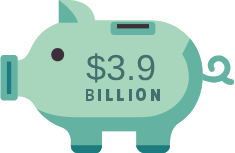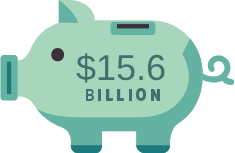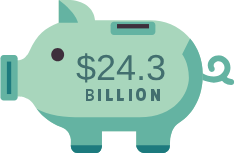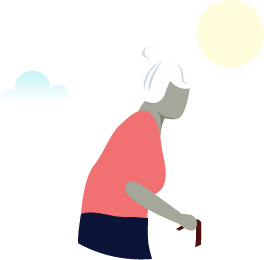
HOW THE 340B
PROGRAM IMPACTS YOU
What is the 340B drug discount program?
The 340B program was established nearly three decades ago to help safety-net hospitals and clinics provide care to vulnerable or uninsured patients. Since then, the program has experienced rapid and unchecked growth, and there’s concern patients aren’t the ones benefiting from it.

HOW DOES IT WORK?
340B enables health care providers, such as qualifying hospitals, federally qualified health centers (FQHCs) and federal grantees, to access medications at a discounted price. The program was intended to help these entities redirect the savings from 340B to expand care and benefit the patients who are most in need.
Let’s be clear — good actors within the program, such as FQHCs, safety-net clinics, and other federal grantees, provide much-needed care to patients who otherwise may not receive it. They regularly report to the government how they are doing so. Here are a few examples of providers that serve as the backbone of the safety-net program:
However, some bad actors within the program, particularly large, private, non-profit disproportionate share hospitals (DSH), have exploited it to increase their bottom lines.
It’s important to note, that unlike these grantees, hospitals are not required to report to the government how they are using the program to help patients.

Among the new DSH hospitals participating in the 340B program for the first time in 2015, nearly 7 out of 10 had lower reported charity care levels relative to when they were not enrolled in the program. In fact, 64 percent of 340B hospitals have charity care rates below the 2.2 percent national average for all hospitals.

So the question is:
HOW DOES IT WORK?
So the question is:
HOW DOES IT WORK?

HOW ARE
HOSPITALS PROFITING?
Many not-for-profit DSH hospitals are buying drugs at the 340B discounted price, charging patients the undiscounted price, and then they keep the difference. There is no clear evidence they are using that money to expand care to needy patients. Financial incentives and a lack of transparency have led many DSH hospitals and hospital systems participating in the program to acquire independent physician clinics and practices to increase the volume of drugs they can purchase at a steeply discounted price.
The result is 340B-driven hospital
consolidation, which means limited access and fewer choices for patients, particularly in rural communities.
HOW DID IT GET
OFF TRACK?
Initially, few hospitals participated in the program, but a lack of government oversight or clear rules led to its rapid expansion. In fact, it took 15 years after 340B’s enactment for annual 340B sales to reach $3.9 billion. But in the next 9 years, between from 2012 to 2016, the 340B program grew more than four-fold in terms of sales, and by 2018, 340B sales had reached $24.3 billion, 26% more than in 2017. Today, sales under the program have exceeded over $54 billion with no sign of stopping anytime soon.
-

2005
-

2016
-

2018
-

2023

IF YOU'RE A PATIENT SEEKING CARE FROM A 340B-COVERED
ENTITY...
HOW ARE YOU AFFECTED?
LET'S TAKE YOU THROUGH "A PATIENT'S JOURNEY."
A Patient’s Journey:
Present and Future
Let’s take a look at what it’s like to be a 340B patient today — the good and the bad. This will shed some light on the disparities within the program, and what’s at stake for patients around the country if the program isn’t fixed.
Click each person to explore their journey.
If 340B isn’t fixed, you can expect the landscape of health care choices to go from this…
TO THIS…
Good actors, like grantees, provide access to care for America’s vulnerable or uninsured patients like John. They serve as the backbone of the U.S. health care safety-net.
But for patients like Rosie and Carol, 340B DSH hospitals’ abuse of the program is hurting their access to care. What happens if Rosie, Carol — or you — get sick and your local physician’s office is gone? 340B keeps growing, yet patients aren’t always getting the help they need. Instead, 340B is driving up costs for all patients.

WHERE DO WE GO NEXT?
340B is an important program that serves a critical safety-net role for our most vulnerable patients and communities. When the program works as intended, public health outcomes are improved. So how do we get the program back on track so it works for patients?
The good news is this: there are several commonsense ways that Congress and the Administration can improve 340B.
1. Define a 340B eligible patient
Today, lax program requirements have allowed some hospitals to game the program and claim discounts for medicines given to patients that weren’t even treated at a 340B facility. Clarifying the definition of a 340B-eligible patient will help ensure 340B DSH hospitals are using the program to help needy patients.
2. Transparency for 340B DSH Hospitals
Unlike federal grantees that are required to report how they use 340B to support the patients they serve, participating DSH hospitals face no reporting requirements. As a result, there is no way for the Administration to know if these hospitals are using the program appropriately. Reporting requirements are needed to provide a line of sight into hospital use of the program and to ensure 340B discounts are targeted to facilities serving vulnerable communities.
3. Restrict Contract Pharmacy Arrangements
While the program was created to support non-profit entities, for-profit retail pharmacies like Walgreens and CVS have flooded the program and are able to split some of the profit with hospitals. Policymakers should re-evaluate the role of contract pharmacies and determine if their participation is helping patients.
#WHOISBENEFITING ?
There is a lot of work that must be done to address the socioeconomic barriers to health care. Strengthening the 340B program is an important step toward restoring a critical safety-net and improving patient outcomes for America’s uninsured, low-income, and vulnerable communities. By advancing policies that will create greater accountability for 340B hospitals, Congress will level the playing field for all 340B participants and address the fundamental issues within the program that have led to rising costs for all patients.
LET’S WORK TOGETHER TO FIX 340B.
VISIT 340BREFORM.ORG TO LEARN MORE.


